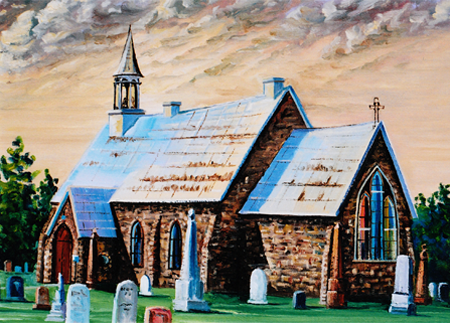150 Years Of History

Painting by Gilles St-Laurent / gilstlaurent.art@ccapcable.com
The wondrous beauty and the promise of a new future began to attract settlers to the valley of the Jacques Cartier River in the early 19th Century. Although still mainly a wilderness in 1815, four leading men from Québec City – the Honourable John Neilson; the Honourable Andrew Stuart; Louis Moquin, advocate; and Nicolas Vincent, Chief of the Huron Tribe – formed an association and purchased a large tract of the former Jesuit Estates held by the government. Very shortly after, the settlements of St. Gabriel de Valcartier East and West were established. Men experienced with clearing forested lands were brought in and many Scottish immigrants were enticed by generous offers of farm land. A road soon linked the fledgling settlements to Lorette. A saw- and a grist-mill were also built, further encouraging growth.
The first Church of England services were conducted by clergy who travelled out from Québec City. Reverend G.J. Mountain, son of the Bishop and Rector of the Cathedral, performed a number of Baptisms on September 12, 1818. For the next several years, the area was visited by the “Preacher to Protestant Settlements adjacent to Québec” and services were held in homes of the parishioners. However, as the congregation grew, the need for a proper Church became quite apparent. In 1844, the Honourable John Neilson donated the land on which Christ Church and its cemetery now stand. At the time, a small wooden house stood on the lot and was used as a Church. The Chancel of the new Church is believed to be built on the site of that wooden house. In 1855, some 90 acres of land was donated to the congregation by the Honourable Joseph Cauchon, commissioner of Crown Lands. This land (along what is now Redmond Road) and two other lots were later sold. One acre was reserved upon which a Parsonage was built (located adjacent to what is now the municipal softball field).
Reverend Edward Cullen Parkin, the first known resident minister, was appointed Incumbent of Valcartier, Stoneham and Lake Beauport in 1844. Reverend Parkin worked tirelessly, and the little Church grew and prospered until the original building became too small and plans were made to build a new, larger building. Over many years, the congregation worked hard to raise funds and gather materials to build their Church. Tradition has it that an officer killed in the Crimean War bequeathed a sum of money for the construction of a new Church. We do know that the stained glass windows were donated in memory of Major George Ranken, a royal engineer, who had helped raise funds to build the Church but, sadly was killed at Sebastopol in 1856, some seven years before it was built. It is believed that his company of Royal Engineers, stationed at the Citadel in Québec City, built the Church based on the design of an old parish Church in England. The new Church, a beautiful Gothic stone structure, opened for worship on Christmas Day, 1863. The first child baptised in the new Church was Eliza Neil on March 27, 1864.
At least twice, fire ravaged the Parsonage, once in 1876 and again about ten years later. The first fire destroyed all the original marriage, burial and baptismal records prior to 1876. Fortunately, duplicates were kept at the Cathedral in Québec City. Extensive repairs were done to the Parsonage in the 1930s.
In January 1945, at the annual Vestry meeting, the congregation decided to celebrate 100 years of service (since acquiring the land for the Church) by building a Parish Hall on the grounds of the Parsonage. The Hall would serve to fill the needs for the social life of the parish and as a recreation centre for the younger members of the community. Through donations of money and lumber, and with the hard work of Wallace Robinson, the Parish Hall was quickly built. Although still under construction, it was put to use for the first time on July 12, 1945. A month later, on August 15, the large crowd who attended the annual bazaar and dance were able to see the newly completed stage and almost finished Hall. The Archbishop officially opened the Parish Hall on September 26, 1945. The hall, some 60 feet long and 24 wide with 12 foot ceilings, was well lit with 20 electric lights and 5 wall plugs. There was a 16 × 14 foot stage, under which was found a roomy kitchen. The stage curtain was mulberry-coloured velour. The roof was metal, and the exterior walls were covered with “roll-brick” shingles.
Today, nearly 150 years after its consecration, the beautiful Gothic stone structure of Christ Church stands as a monument to the energy, foresight and sacrifices made by the congregation in order that their children and grandchildren may have a fitting place for the worship of Almighty God. Although, now the congregation is much smaller – the Parsonage sold; and the Parish Hall gone – they continue the noble efforts begun by their forbearers so that future generations may in turn enjoy the fruits of their labours. While many clergymen have ministered to the people of Valcartier over the years, the congregation remains committed and faithful to its traditions.
Services are held every first and third Sunday of the month from April to December; and once a month on the third Sunday during the cold months of January, February and March.